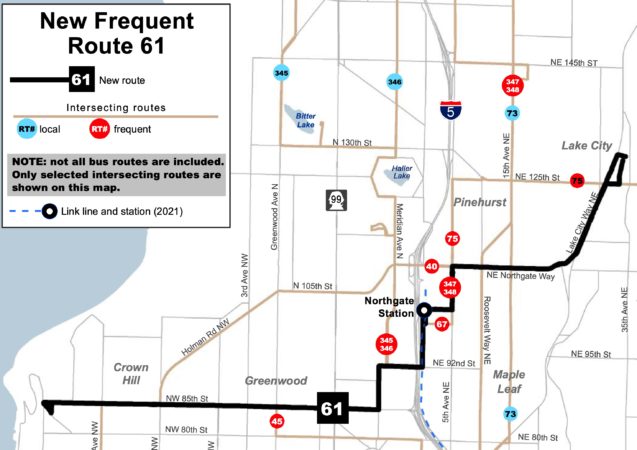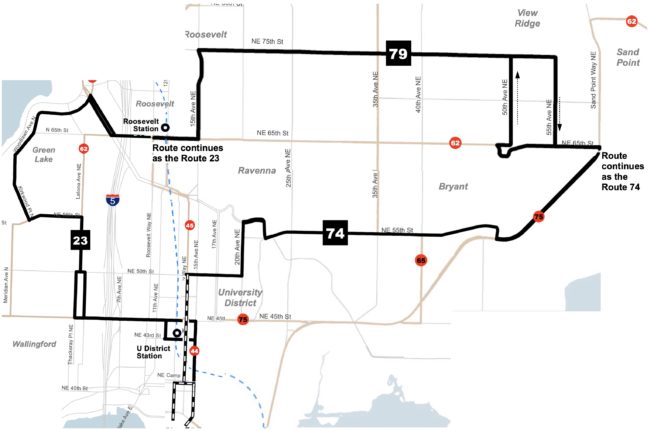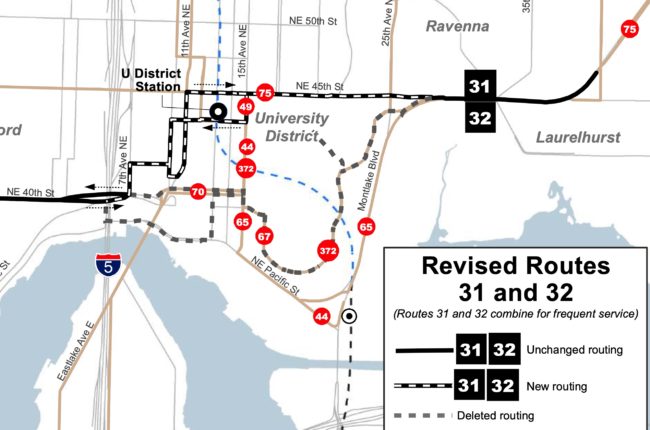Metro proposes new network for North Link
 Metro map of the proposed network, zoomed out.
Metro map of the proposed network, zoomed out.In 2021, Sound Transit's Northgate Link Extension will add three new stations to the light rail line formerly known as Central Link: University District, Roosevelt, and Northgate. As with previous Link extensions, Metro plans to restructure bus service to improve connections to the new stations and reduce duplication with new light rail service. Given the large, heavily populated swath of North Seattle that the Northgate Link stations will serve, we expected this restructure to be particularly far-reaching. And Metro's first proposal does not disappoint.
In the broadest terms, Metro wants to leverage Link for almost every trip where it could make sense, and to shift bus hours from redundant trips downtown into local routes and commuter service to destinations Link doesn't reach. Riders traveling between the north end and downtown can expect to use light rail for at least part of their trips, while many riders within North Seattle will have new nonstop connections and buses that run more often.
Before we dive into what it means for specific areas (below the jump), we should note that this proposal is about high-level network concepts more than granular details. Metro is offering only general information about the level of service riders can expect on each proposed route, and says that it intends to gather feedback about specific tradeoffs during community outreach that will happen over the next few months. Based on experience of past Link proposals, it's possible that this one could barely change, that it could be redrawn wholesale, or anything in between-depending on feedback Metro receives. Tell Metro what you think, whether or not you like what you see. Their survey is open until April 7.
Northgate and Points NorthNorthgate may be the clearest demonstration of Metro's intent. To go downtown from Northgate, Metro really wants you to use Link-and it will be faster than a bus for nearly all trips. A massive number of service hours from route 41, currently one of Metro's busiest routes, are redeployed in a variety of ways. There is a brand-new high-frequency crosstown route, significant frequency improvements to other nearby services, and reinforcements of commuter service to South Lake Union and First Hill.
New Crosstown Route 61This new route (map below) would radically shorten a lot of east-west trips. Running at least every 15 minutes at most times of day, it would connect Lake City, Northgate, Greenwood, and Crown Hill, running via Northgate Way and N 85th St. It would restore a one-seat Greenwood-Northgate connection that has been missing since route 5-Northgate trips were deleted; provide a much faster connection than route 40 from Crown Hill to Northgate; and give Lake City riders a frequent one-seat connection to points west of Northgate for the first time. It would revise commuter trips for Crown Hill-UW riders to use Northgate Station, because it would replace the portion of route 45 west of Greenwood.
Other changes to the Northgate-area all-day network would be relatively minor. Service on the part of route 41 north of Northgate would be replaced by route 75, which will be moved from the routing taken over by the new route 61. (Expect route 75 to be further revised to serve Bitter Lake, rather than Northgate, when 130th Street Station opens.) Route 26X would be deleted, with service replaced either by more frequent route 61 or new connections from Roosevelt Station described below.
Commuter Service ChangesCommuter service from Northgate and its surrounding areas would change significantly. Almost everyone riding downtown on current commuter service-including everyone now going downtown on routes 41, 77, 301, 304, 308, 312, 316, 355, and 522 - would use a Link transfer. To make these transfers more palatable, local routes 345, 346, 347, and 348 would all get frequency increases to every 10 minutes along the common 345/346 and 347/348 segments, and commuter routes truncated at Northgate would also gain more frequency.
Fortunately, ST and Metro appear to have learned from past mistakes, and these transfers will be far more pleasant than some at other Link stations. Buses will terminate at a new off-street station directly below the Link tracks, and riders will not be required to cross streets, walk long distances, or get rained on.
Metro would substantially improve commuter bus service from Northgate to the growing employment centers in South Lake Union and First Hill. Today's route 63 service between Northgate and SLU would be replaced by new route 68, which would run more often and extend service for the first time to Uptown and the new Expedia campus on Elliott Bay. First Hill service on route 303 would be supplemented by new route 302, which would also extend First Hill connections to parts of Shoreline and Richmond Beach for the first time.
RooseveltThe area around Roosevelt Station will see farther-reaching changes to its all-day network. This network primarily serves north/south trips today, and will be revised substantially to improve east/west connections to Link.
Frequent ServiceThe core of Metro's Roosevelt proposal is four frequent routes-routes 45, 62, 67 and ST 522-that will allow people to reach Roosevelt Station from most nearby neighborhoods quickly and reliably. These routes are all familiar to riders today, but all change a bit.
On its north end, route 45 will avoid the quicksand-like intersection of 85th and Aurora, using less congested N 80th St to travel between Green Lake and Greenwood. It would no longer operate west of Greenwood; Crown Hill riders would instead use route 61 to Northgate, with Link transfers to Roosevelt or the U-District. On the south end, route 45 would be shortened to terminate south of U-District Station, not continuing all the way to UW Station.
East of Roosevelt Station, route 62 would use today's routing via NE 65th St (although Link will obviously make the route far more useful). West of the station, the route would be revised to speed service between Wallingford and Roosevelt, with the windy segment along Kirkwood Pl N and Woodlawn Av N covered instead by local route 23 (described below).
Route 67 won't change near Roosevelt, although its routing in the U District will change to allow easier connections at U District Station.
ST route 522 (and its peak-hour Metro shadow, route 312) would be revised to terminate at Roosevelt Station instead of continuing all the way downtown. In exchange, they would run twice as often at most times of day. The change would also make the routes useful for north Seattle and U District connections they don't serve today, finally replacing former route 72 service to south Lake City that many riders still miss.
New Local ConnectionsIn addition to those frequent routes, Metro would revise local service for additional connections to Roosevelt. Route 73 would get a slight deviation to allow for transfers without walking from 15th Ave NE. But the far more interesting news is a set of three local routes which would actually operate as a single loop route, originating and terminating in the U-District. New routes 23 and 79 would be combined with existing route 74 to cover areas near Roosevelt and U District stations that otherwise wouldn't receive service. Because presenting them as a single route gives a much clearer picture of the connections they offer, I made a primitive mashup from Metro's maps.
These routes would offer local service along the length of NE 75th St for the first time; preserve a one-seat ride from View Ridge to the U District despite the deletion of mostly-redundant route 71; connect Latona and Tangletown to the U District; replace the Woodlawn Av N connection currently provided by route 62; and finally connect route 74 riders with U District Station and other U District connections.
Metro's "Local" frequency designation probably means 30-minute headways off-peak, but we don't know yet whether headways will be 15 minutes at peak, which would make the new loop considerably more useful for commute connections.
Commuter Service ChangesAs at Northgate, many Roosevelt-downtown commuters would find themselves using Link, while Metro would improve connections with non-Link destinations. Routes 26X, 76, and 316 would be replaced, mostly with Link connections (although a new peak route, route 25, would serve some route 26X and 316 riders not well positioned to connect to Link). Especially in the afternoon, Link should meaningfully speed up downtown commuter trips. Meanwhile, route 64 would receive more trips, to improve commuter service to South Lake Union and First Hill, and to provide a better Link connection to north Wedgwood.
University DistrictMetro proposes few major network changes in the U District, likely because most routes are already oriented toward the central U District. But there are many minor route adjustments to improve Link connections at U District Station.
The largest change is to routes 31, 32, and 75, which are all through-routed and together form a frequent corridor between Seattle Pacific, Fremont, University Village, and Sand Point. They currently serve the UW main campus, but would instead serve U District Station and NE 45th St (as pictured below). This would create a much faster frequent connection between University Village and U District Station, and speed many bus-bus transfers as well.
There are also lesser revisions to routes 44, 45, 48, 65, 67, 70, 73, 74, and 372 for better U District Station connections. Local connections to some neighborhoods west of the U District would be added through new local route 23, fully described above.
A few U District routes would be replaced by Link connections. Route 71 would be replaced by route 62 and Link for some riders, and through-routed routes 79 and 74 for others. Route 355 would be replaced for some riders by route 345 and Link, and for others by new peak-only route 16. Route 373 would be replaced for most riders by improved service on route 73, and for others by connections to Link at Northgate. Link would entirely replace the portion of route 74 between downtown and the U District. The low-ridership route 78 to Laurelhurst would disappear, with its one weekday bus reinvested into more productive service. Its accessible service between the UW main campus and Link would be replaced by connections to U District Station on routes 65, 67, and 372.
It's worth noting that this proposal does not fix one stubborn point of confusion in the U District: the division of north/south service between University Way NE ("The Ave") and 15th Ave NE. Routes 45 and 73 remain on The Ave, while routes 44, 48, 70, and 271 remain on 15th Ave NE, and routes 65 and 67 move to 15th Ave NE. While hardly the end of the world, this division does complicate bus-bus transfers a bit, and it would be nice to see it resolved.
Final ThoughtsEvery time they restructure service around a new Link station, the agencies ask riders to take a leap of faith-faith that transfers won't make existing trips worse, and that more frequency and new connections will make new trips possible. Riders in northeast Seattle took that leap just three years ago with the major UW Station restructure, and were rewarded handsomely. Earlier in Link's story, rewards weren't as clear; the full potential of Rainier Valley stations has yet to be realized, because of poor transfer environments and a lack of east-west connections.
But Metro (and its sister agencies Community Transit and Sound Transit, which are making similar proposals) have learned sometimes painful lessons from their Link experiences. Transfers at all three stations should be relatively painless, and the elimination of many I-5 delays will be a boon to peak-hour commutes. There are real connections in all directions from the three stations, and the new east-west connections at Northgate and U District are meaningful.
Especially for downtown commuters, this restructure will be a leap. But the new connections Metro's proposal would enable are significant, and the promise of reinvesting future service hour additions in a good local network rather than endless sitting in I-5 traffic jams is great. While there are plenty of details to work out over the coming months, Metro's proposal is a step in the right direction.


